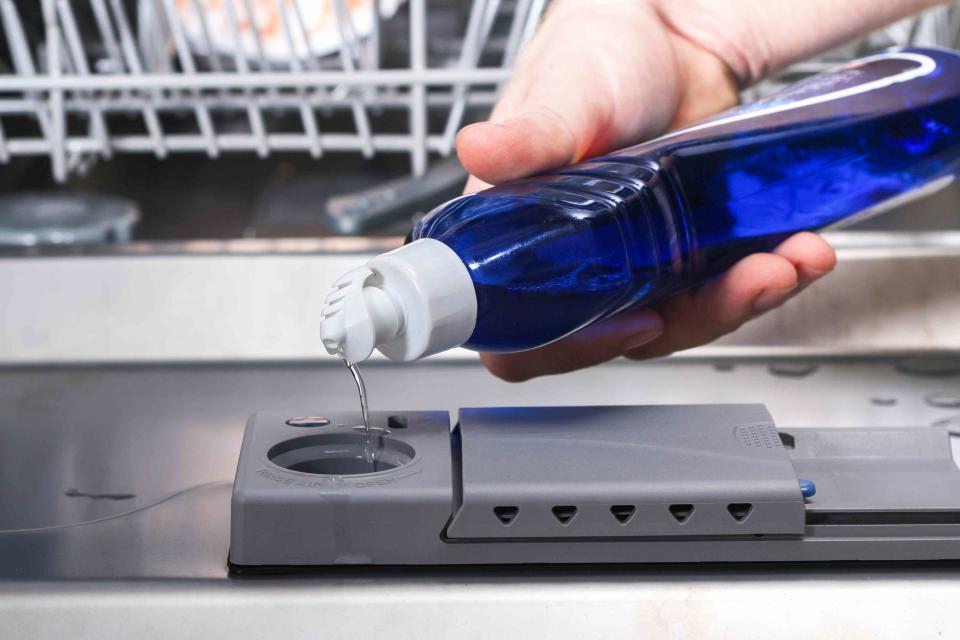What Is Rinse Aid and Do You Actually Need It?
This booster improves the function of your dishwasher, making it a worthwhile purchase.

Getty Images / Detry26
When it comes to using a dishwasher, a great deal of attention is paid (and a great many opinions offered!) to loading the appliance correctly. But ensuring that dishes come out of the dishwasher spot- and streak-free takes more than just proper loading. If you aren't using a rinse aid, chances are that even the most flawlessly loaded dishes will come out looking less than clean.
But what exactly is rinse aid? And is rinse aid a product you need to be using?
What Is Rinse Aid?
Rinse aid is a bit of a misnomer—a more accurate name would be 'dry aid' because rinse aid is actually a drying agent. Rinse aid improves the function of a dishwasher by boosting the appliance's drying function, leaving dishes dryer and with fewer water spots.
Rinse aid is a standalone liquid product that is purchased separately from dishwasher detergent. Although many detergent packs contain a small amount of rinse aid, regular rinse aid should still be used to promote better drying.
How Rinse Aid Works and How to Use It
Rinse aid is a surfactant—it works by lowering the surface tension of water, allowing it to slide off dishes, aiding draining in the dishwasher.
Rinse aid is dispensed during the final rinse cycle. It promotes better drying by helping water run off of dishes and the inside of the dishwasher, leaving dishes dryer and reducing water spots, streaks, and chalky white residue. Rinse aid also helps the heat-dry option perform better.
To use it, fill the rinse aid dispenser, which is usually located on or next to the detergent dispenser, to maximum capacity and close it. The dishwasher will automatically dispense the rinse aid during the final rinse cycle.
Some dishwasher models don't have a rinse aid dispenser, in which case you can purchase a separate rinse aid basket that hangs from the top rack of the dishwasher. While many detergent pack formulas include a small amount of rinse aid, it is still recommended that you use a liquid rinse aid, either in the dispenser or in a standalone rinse aid basket, to promote better drying.
Related: The 10 Best Dishwasher Detergents for Sparkling Dishes and Drinkware
Who Should Use Rinse Aid?
Most households will benefit from using a rinse aid in the dishwasher. Specifically, if you notice the following things on dishes after using your dishwasher, it is a signal that a rinse aid is needed:
Water spots
Streaks
Filmy residue
White, chalky residue
Scale or mineral deposits
Excessive moisture or puddling
Additionally, if you live in an area with hard water, the use of a rinse aid is crucial to preventing the buildup of mineral deposits on your dishwasher. Many dishwashers allow you to adjust the amount of rinse aid dispensed into the rinse cycle; if hard water is an issue where you live, or if you notice that there are rings or calcium spots from hard water on dishes, adjust the setting to dispense more rinse aid.
Alternatives to Rinse Aid
You may have read that distilled white vinegar can be used as an alternative to rinse aid, and while it does have properties that help to reduce the appearance of water spots and mineral deposits, it is not recommended for regular use in dishwashers. Distilled white vinegar is highly acidic and, over time, exposure to acids can damage the dishwasher's rubber parts like hoses and gaskets. Therefore, we strongly recommend using a rinse aid specifically formulated to be safe on dishwashers.
There are also some ways to use your dishwasher to improve its functionality:
Load dishes at an angle to encourage water to run off
Leave space between dishes so that they are not touching
Reduce the amount of plastic in the load
Use the correct amount of detergent
Use the heated dry setting
When unloading, start with the bottom rack
Unload plastic items last
If you live in an area with hard water, installing a water softener can help to address the problem at the root. Water softening systems can be expensive, with an average cost of $1,500 according to HomeAdvisor, but if the water in your home has a hardness of over 7 grains per gallon (GPG) it can be a worthwhile investment. A water softener will improve the quality of your home's water, making it gentler on skin, hair, clothing, household linens like sheets and towels, as well as on major appliances and plumbing.
How Often to Use Rinse Aid
Rinse aid is automatically dispensed during the dishwasher's rinse cycle, so as long as the dispensing chamber remains filled, you do not need to worry about adding it to each wash cycle.
Most dispensers have a 5-ounce capacity, designed to hold a month's worth of rinse aid for an average-sized household with typical dishwasher usage. Most people will find that they need to refill the rinse aid once a month; if your household has atypical dishwasher use, you can top the rinse aid off on an as-needed basis.
For more Better Homes & Gardens news, make sure to sign up for our newsletter!
Read the original article on Better Homes & Gardens.

